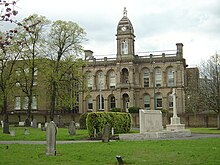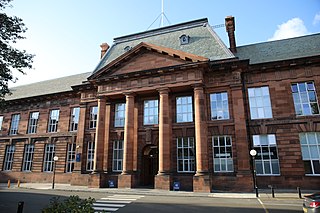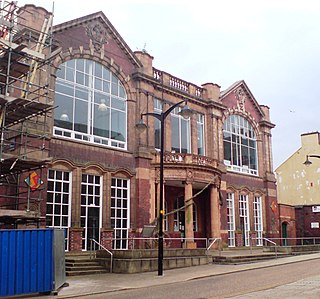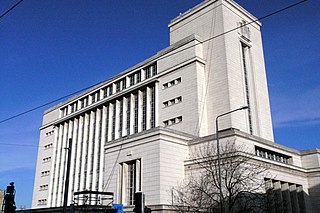This article needs additional citations for verification .(March 2011) |
Founded in 1843, the School of Art & Design at Nottingham Trent University is one of the oldest in the United Kingdom. [1]
This article needs additional citations for verification .(March 2011) |
Founded in 1843, the School of Art & Design at Nottingham Trent University is one of the oldest in the United Kingdom. [1]

In 1836, the Government Select Committee on Art and Manufactures produced a report highlighting concerns about the standard of design in the industry. Higher standards abroad forced manufacturers to buy or copy foreign designs. Later in 1836, the Board of Trade established the ‘Government School of Design’ in London, where, in 1837, it opened at Somerset House. [2]
In order to encourage Practical Art in other populous areas of the UK, a ‘Government School of Design’ was then established in each of several provincial towns, where manufacturing industries were already in existence. Inevitably, the original title was adjusted to include the name of the town where it was located – whilst locally, being simply referred to as, the ‘School of Design’.
The ‘School of Design’ opened on the 1 April 1843, at the People's Hall [6] in Beck Lane (now Heathcote Street), moving to Plumptre House in Stoney Street in 1852, and to Commerce Square, off High Pavement, in 1858. In 1863, a site was purchased in Waverley Street for the construction of a building specifically for the school.
Building work started on 23 May 1863 but the foundation stone wasn't laid until 22 October that year when Henry Pelham-Clinton, 5th Duke of Newcastle was available for the ceremony. [7] The school was opened by Henry Pelham-Clinton, 6th Duke of Newcastle on 19 June 1865. The architect was Frederick Bakewell. In front of the building is a statue of the artist Richard Parkes Bonington, produced by Watson Fothergill.
Nottingham Trent University's City site is based close to Nottingham city centre.
The School of Art and Design is based at the university's City site, about half a mile from the city centre.
All of NTU's art and design courses are based at three buildings on the university's City site.
Bonington building — a labyrinthine three-story building.
Opened in 1969 by the Duchess of Kent, [8] and upgraded in 2005. Included in the design, at the heart of the building, is a high-ceilinged exhibition space, known as 'Bonington Gallery'. It is one of the oldest art galleries in Nottingham. [9] Bonington was officially re-opened in May 2006 by Sir Paul Smith. [10]
Waverley building — a restored, listed building with design heritage.
The Waverley building houses the Nottingham School of Art and Design since 1865. As part of the NTU's buildings regeneration plan, and in recognition of its importance and provenance, the university arranged for constructional adjustments and refurbishment to upgrade all the facilities, including an exhibition space, disabled access and an improved environment for both staff and students. The upgrade being completed in the year 2000 at a cost of £1.4M [11]
Maudslay building — a centre for industry and technology.
During 2006, the Maudslay building was upgraded to incorporate design facilities and studios.
Courses are offered at undergraduate levels (BA Hons in numerous disciplines) [14] and also MAs [15] in a wide range of subjects.
There is an MA by 'Registered Project or thesis', offered as a flexible postgraduate course, allowing students to tailor their course specifically around their areas of individual interest. [16] There are a variety of Part-time, Art and Design MA courses beginning in 2024 and 2025. [17]
In the field of art and design, NTU [18] has links with a wide range of companies, professional bodies and institutions on an international level, including Apple, Arcadia Group, Boots (company), Broadway, [19] Fashion Institute of Technology, Association of Illustrators, Marks & Spencer, Sony, and Sophie Steller. [20]
The university has international liaison staff, course tutors and trained counsellors to give international students advice and practical help, and also offers a detailed orientation programme the week before term begins. [21] University representatives regularly travel to international education fairs to give advice and information to overseas applicants. [22]
NTU has links across Europe, the United States, Japan, Korea, China, Australia, India, Africa, and the Far East, both through individual contacts and exchange programmes. [23]
Many of NTU's undergraduate courses offer the opportunity to spend time studying at a university overseas. Students can do this in Europe through the Erasmus Programme, previously known as the Socrates programme from 1994 until 1999, and then Socrates II from 2000 until 2006. For countries worldwide, there is the university's study abroad scheme. [24]
In early 1973, R. Lyon, the deputy director of Trent Polytechnic, and W. Payne, the Associate Head of the Graphics Department of the College of Art, were approached by the Nottingham Forest Football Club, for advice regarding the design of a new badge. The Nottingham Evening Post Sports Editor was then consulted, resulting in a competition being organised, which was announced in March 1973. [25] There were 855 entries, some from other countries. (587 in the adult section and 268 in the junior section.)
The winning design was by Trent Polytechnic graphic designer and lecturer, David Lewis. [26] To maintain anonymity, Lewis entered his design using his mother's maiden name. The reason being, that one of the five judges was W. Payne, his head of department at Trent Polytechnic. [27] After winning the competition, Lewis adapted his entry to produce the final design. His explanation, describing the new badge, is reproduced below, as printed on page eleven in the Forest Programme of Saturday 8 September 1973:
' The main visual elements in the final design: Equal thickness of heavy line treatment gives a ″completeness″ (fairly weighty appearance is much more likely to identify with supporters than a spindly one). The straight and relatively short tree trunk gives strength and prevents the tree top and the water becoming too separate. The tree achieves a unique quality through its shape — the triangular shape adds stability. The small ″E″ in ″Forest″ helps give a personal identity to the name — it becomes something more unique than just the word. [28] [29]
David Lewis — Designer/Lecturer in Graphic Design, Trent Polytechnic. '
The University of Brighton is a public university based on four campuses in Brighton and Eastbourne on the south coast of England. Its roots can be traced back to 1858 when the Brighton School of Art was opened in the Royal Pavilion. It achieved university status in 1992.

The Victoria and Albert Museum in London is the world's largest museum of applied arts, decorative arts and design, housing a permanent collection of over 2.27 million objects. It was founded in 1852 and named after Queen Victoria and Prince Albert.

Sir Basil Urwin Spence, was a Scottish architect, most notably associated with Coventry Cathedral in England and the Beehive in New Zealand, but also responsible for numerous other buildings in the Modernist/Brutalist style.

Nottingham Trent University (NTU) is a public research university in Nottingham, England. Its roots go back to 1843 with the establishment of the Nottingham Government School of Design, which still exists within the university today. It is the sixth largest university in the UK with 35,785 students split over five different campuses in Nottingham. The university has most recently opened a new campus in London.

Chelsea College of Arts is a constituent college of the University of the Arts London based in London, United Kingdom, and is a leading British art and design institution with an international reputation.

The School of the Museum of Fine Arts at Tufts University is the art school of Tufts University, a private research university in Boston, Massachusetts. It offers undergraduate and graduate degrees dedicated to the visual arts.

Staffordshire University is a public research university in Staffordshire, England. It has one main campus based in the city of Stoke-on-Trent and four other campuses; in Stafford, Lichfield, Shrewsbury and London.

Edinburgh College of Art (ECA) is one of eleven schools in the College of Arts, Humanities and Social Sciences at the University of Edinburgh. Tracing its history back to 1760, it provides higher education in art and design, architecture, history of art, and music disciplines for over three thousand students and is at the forefront of research and research-led teaching in the creative arts, humanities, and creative technologies. ECA comprises five subject areas: School of Art, Reid School of Music, School of Design, School of History of Art, and Edinburgh School of Architecture & Landscape Architecture (ESALA). ECA is mainly located in the Old Town of Edinburgh, overlooking the Grassmarket; the Lauriston Place campus is located in the University of Edinburgh's Central Area Campus, not far from George Square.

The Birmingham School of Art was a municipal art school based in the centre of Birmingham, England. Although the organisation was absorbed by Birmingham Polytechnic in 1971 and is now part of Birmingham City University's Faculty of Arts, Design and Media, its Grade I listed building on Margaret Street remains the home of the university's Department of Fine Art and is still commonly referred to by its original title.
Simon Starling is an English conceptual artist and won the Turner Prize in 2005.

Burslem School of Art was an art school in the centre of the town of Burslem in the Potteries district of England. Students from the school played an important role in the local pottery industry. Pottery was made on the site of the school from the early Middle Ages. The venue was refurbished and re-opened for the arts in 1999.
The University of Nottingham operates from four campuses in Nottinghamshire and from two overseas campuses, one in Ningbo, China and the other in Semenyih, Malaysia. The Ningbo campus was officially opened on 23 February 2005 by the then British Deputy Prime Minister, John Prescott, in the presence of Chinese education minister Zhou Ji and State Counsellor Chen Zhili. The Malaysia campus was the first purpose-built UK university campus in a foreign country and was officially opened by Najib Tun Razak on 26 September 2005. Najib Tun Razak, as well as being a Nottingham alumnus, was Deputy Prime Minister of Malaysia at the time and has since become Prime Minister of Malaysia.

The University of Nottingham is a public research university in Nottingham, England. It was founded as University College Nottingham in 1881, and was granted a royal charter in 1948.

Nottingham Conference Centre is a modern conference facility in the heart of Nottingham city centre. It was created in 2009 as part of the Newton-Arkwright regeneration development at Nottingham Trent University and designed by Hopkins Architects.

The John Lennon Art and Design Building in Liverpool, England, houses Liverpool John Moores University's School of Art and Design. The school was formerly located at the Grade II listed Liverpool College of Art, which now houses LJMU's School of Humanities and Social Science.
John David Lloyd is a British graphic designer who in 1975 co-founded the international design consultancy Lloyd Northover. He has worked in all fields of graphic design but has specialised in corporate identity.

Kingston University London is a public research university located within the Royal Borough of Kingston upon Thames, in South West London, England. Its roots go back to the Kingston Technical Institute, founded in 1899. It received university status in 1992, before which the institution was known as Kingston Polytechnic.
Spike Island is an international centre for contemporary art located in Bristol, UK.
The Juggernaut of Nought is a steel and cast iron sculpture by Richard Trupp. The sculpture was originally exhibited in 2011 in the grounds of Great Fosters Hotel in Surrey, England. Of this installation Trupp said "I intended the site-specific sculpture to look like a sculptural exclamation mark in the rural environment. It asks questions of its own existence. Where did it come from? What is it doing here? Is it safe?"
Confetti Institute of Creative Technologies is a specialist education provider with courses in the Creative Industries. It delivers college courses validated by Access Creative, with undergraduate and postgraduate courses being validated and run through Nottingham Trent University. It has 2 campuses, the original Nottingham campus on Convent Street, and a London campus on Commercial Road in Whitechapel.